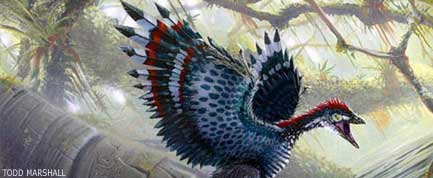
The earliest known bird had flight feathers on its legs that allowed it to use its hindlimbs as an extra pair of wings, a new study finds.
The finding, detailed in the current issue of the journal Paleobiology, supports the theory that early birds learned to glide and parachute from trees before achieving full-fledged flight.
"This paper puts forward some of the strongest evidence yet that birds descended from arboreal parachuters and gliders, similar to flying squirrels," said study author Nick Longrich, a doctoral student a the University of Calgary in Canada.
The missing link
Archaeopteryx was a crow-sized animal that lived about 150 million years ago and which looked like a cross between a bird and a dinosaur. It had feathers and a wishbone like birds but also reptilian features like a long bony tail, claws and teeth.
When the first Archaeopteryx fossil was discovered in 1861, it caused a sensation because it was the kind of transitional animal that the British naturalist Charles Darwin predicted in his theory of evolution only a few years earlier.
In 1877, a second Archaeopteryx specimen discovered in Germany showed a curious feature: long feathers covering its hindlimbs. For more than a century, the feathers were dismissed by most scientists as being simple, albeit unusual-looking, insulating body feathers--called "contour" feathers--that didn't play a role in the animal's flight.
Get the world’s most fascinating discoveries delivered straight to your inbox.
But then, beginning in 2002, paleontologists began finding four-winged dinosaurs in China with hindlimb feathers that appeared to be important for gliding and perhaps even flying. In light of the new findings, Longrich decided it was time that Archaeopteryx was reexamined.
Flying with four wings
Longrich examined hindlimb feathers on five Archaeopteryx fossils using a dissecting microscope and found that the feathers had features typical of flight feathers in modern birds, including curved shafts, a self-stabilizing overlap pattern and vane asymmetry, in which the parallel row of barbs that make up the feather are longer on one side than the other.
Next, Longrich used standard mathematical models for flight to calculate how an extra pair of wings would have affected Archaeopteryx's flight. He found that hindlimb feathers would have allowed Archaeopteryx to fly slower and to make sharper turns.
Sharper turns would have improved Archaeopteryx's abilities to maneuver in pursuit of prey, to escape predators and to fly through the cluttered branches of trees and bushes. And the ability to fly slower meant Archaeopteryx had more time to avoid obstacles and to make safer landings.
Longrich speculates that the hindlimb feathers might have served other roles in addition to flight. Like modern pigeons, kittiwakes and vultures, Archaeopteryx's hindlimb feathers might have acted as airbrakes, or perhaps stabilizers, control surfaces or flaps, Longrich writes.
Scientists don't know when in their evolutionary history birds switched from a "four winged" design to a two-wing one, but it's thought that hindlimb wings were sacrificed in order to free up legs for other functions, such as running, swimming and catching prey.
?
"The idea that a multi-winged Archaeopteryx has been around for more than a century, but it has received little attention," Longrich said. "I believe one reason for this is that people tend to see what they want or expect to see. Everybody knows that birds don't have four wings, so we overlooked them even when they were right under our noses."
- Secret of Bird Flight Revealed
- Image Gallery: Rare and Exotic Birds
- Avian Ancestors: Dinosaurs that Learned to Fly
- Birds of Prey: Spot Today's Dinosaurs
